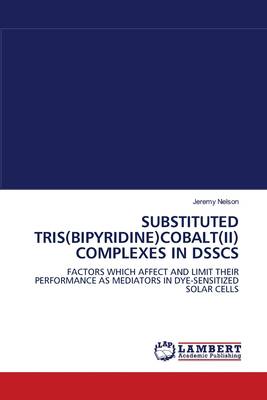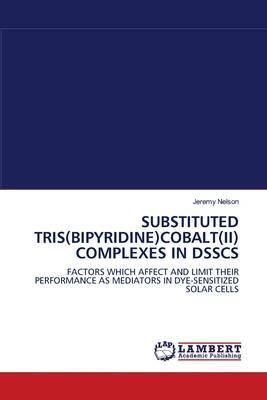
- Afhalen na 1 uur in een winkel met voorraad
- Gratis thuislevering in België vanaf € 30
- Ruim aanbod met 7 miljoen producten
- Afhalen na 1 uur in een winkel met voorraad
- Gratis thuislevering in België vanaf € 30
- Ruim aanbod met 7 miljoen producten
Zoeken
Substituted Tris(bipyridine)Cobalt(ii) Complexes in Dsscs
FACTORS WHICH AFFECT AND LIMIT THEIR PERFORMANCE AS MEDIATORS IN DYE-SENSITIZED SOLAR CELLS
Jeremy Nelson
Paperback | Engels
€ 77,95
+ 155 punten
Omschrijving
Appropriately substituted tris(bipyridine)cobalt(II) complexes (Co-bpy) have been found to function adequately as electron transfer mediators in dye-sensitized solar cells (DSSCs). However, the performance of Co-bpy in DSSCs has so far not equaled that of more traditional mediators based on the iodide/triiodide redox couple. This book primarily focuses on research conducted to investigate the reason for the poorer performance of Co-bpy mediators, although significant attention is also given to efforts to develop a solid-state Co-bpy DSSC. A series of two-electrode experiments was devised and an apparatus built to perform three-electrode experiments, a task made more complex by the thin layer, "sandwich cell" geometry of the DSSC. The results of this work suggested that mass transfer of the Co-bpy is often rate-limiting and significantly slower than that of iodide-based mediators. A mostly theoretical treatment of mass transfer predicted that diffusion within the mesoporous titania layer, rather than an intrinsically slow bulk diffusion rate, is hampering DSSC performance. This work should be of interest to researchers investigating DSSCs or diffusion within nanostructures.
Specificaties
Betrokkenen
- Auteur(s):
- Uitgeverij:
Inhoud
- Aantal bladzijden:
- 240
- Taal:
- Engels
Eigenschappen
- Productcode (EAN):
- 9783838313320
- Verschijningsdatum:
- 31/08/2009
- Uitvoering:
- Paperback
- Formaat:
- Trade paperback (VS)
- Afmetingen:
- 152 mm x 229 mm
- Gewicht:
- 358 g

Alleen bij Standaard Boekhandel
+ 155 punten op je klantenkaart van Standaard Boekhandel
Beoordelingen
We publiceren alleen reviews die voldoen aan de voorwaarden voor reviews. Bekijk onze voorwaarden voor reviews.











